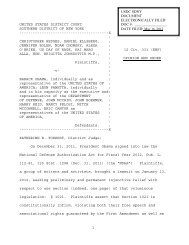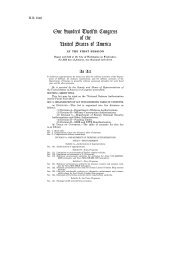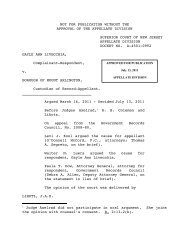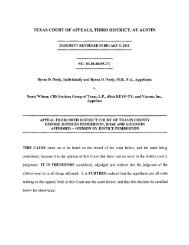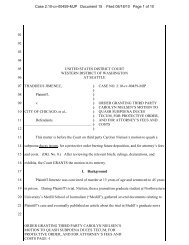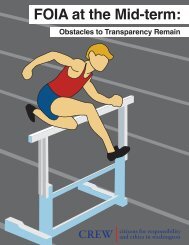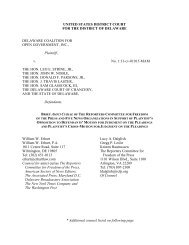Phelps-Roper v. City of Manchester - US Court Of Appeals
Phelps-Roper v. City of Manchester - US Court Of Appeals
Phelps-Roper v. City of Manchester - US Court Of Appeals
Create successful ePaper yourself
Turn your PDF publications into a flip-book with our unique Google optimized e-Paper software.
United States <strong>Court</strong> <strong>of</strong> <strong>Appeals</strong>FOR THE EIGHTH CIRCUIT___________No. 10-3197___________Shirley L. <strong>Phelps</strong>-<strong>Roper</strong>; *Megan <strong>Phelps</strong>-<strong>Roper</strong>, **Plaintiffs - Appellees, **v. **<strong>City</strong> <strong>of</strong> <strong>Manchester</strong>, Missouri, * Appeal from the United States* District <strong>Court</strong> for theDefendant - Appellant. * Eastern District <strong>of</strong> Missouri.*_______________________ * [PUBLISHED]*United States <strong>of</strong> America, **Amicus on Behalf <strong>of</strong> Appellant, **Christina Wells; Thomas Jefferson *Center for the Protection <strong>of</strong> Free *Expression, **Amici on Behalf <strong>of</strong> Appellees. *___________Submitted: June 15, 2011Filed: October 5, 2011___________
1Before MURPHY and SMITH, Circuit Judges, and READE, District Judge.___________PER CURIAM.Shirley and Megan <strong>Phelps</strong>-<strong>Roper</strong> brought this First Amendment challenge toa <strong>Manchester</strong>, Missouri ordinance that regulates protests near funerals. On cross1motions for summary judgment, the district court considered the ordinance asoriginally adopted and as twice amended. It ruled in favor <strong>of</strong> the <strong>Phelps</strong>-<strong>Roper</strong>s,awarding them nominal damages and enjoining enforcement <strong>of</strong> the ordinance. The<strong>City</strong> <strong>of</strong> <strong>Manchester</strong> appeals, arguing that the <strong>Phelps</strong>-<strong>Roper</strong>s lack standing tochallenge the ordinance, that the <strong>Phelps</strong>-<strong>Roper</strong>s' challenges to earlier versions <strong>of</strong> theordinance are moot, and that the ordinance is a constitutionally valid content neutraltime, place, or manner regulation. The <strong>Phelps</strong>-<strong>Roper</strong>s respond that <strong>Manchester</strong>'sordinance is unconstitutional under our court's prior decision in <strong>Phelps</strong>-<strong>Roper</strong> v.Nixon, 545 F.3d 685 (8th Cir. 2008).The <strong>Phelps</strong>-<strong>Roper</strong>s are members <strong>of</strong> the Westboro Baptist Church (WBC),which believes that God is punishing America for tolerating homosexuality. WBCexpresses its views by protesting at funerals, including those <strong>of</strong> American soldiers.Its members hold signs with messages such as "Thank God for Dead Soldiers" and"God Hates You" at protests staged near funerals. Snyder v. <strong>Phelps</strong>, 131 S. Ct. 1207,1213 (2011).In 2007 <strong>Manchester</strong> adopted an ordinance in § 210.264 <strong>of</strong> its municipal coderegulating protests at funerals in response to the WBC's activities. The ordinance wasamended twice, and its final form prohibits "picketing or other protest activities . . .1The Honorable Linda R. Reade, Chief Judge, United States District <strong>Court</strong> forthe Northern District <strong>of</strong> Iowa, sitting by designation.1The Honorable Catherine D. Perry, Chief Judge, United States District <strong>Court</strong>for the Eastern District <strong>of</strong> Missouri.-2-
within three hundred (300) feet <strong>of</strong> any residence, cemetery, funeral home, church,synagogue, or other establishment during or within one (1) hour before or one (1)hour after the conducting <strong>of</strong> any actual funeral or burial service at that place."<strong>Manchester</strong>'s ordinance now closely resembles a similar statute that the Sixth Circuitupheld over First Amendment challenges in <strong>Phelps</strong>-<strong>Roper</strong> v. Strickland, 539 F.3d356, 373 (6th Cir. 2008).After the <strong>Phelps</strong>-<strong>Roper</strong>s challenged the constitutionality <strong>of</strong> the <strong>Manchester</strong>ordinance, the district court concluded that they had standing to bring their claims andthat their challenges to earlier versions <strong>of</strong> the ordinance were not moot. The courtdecided that the second and third versions <strong>of</strong> the ordinance were content based, butthat even if they were content neutral, they would have still violated the FirstAmendment. The district court concluded that each version violated the FirstAmendment, permanently enjoined enforcement <strong>of</strong> the ordinance, and awardednominal damages to the <strong>Phelps</strong>-<strong>Roper</strong>s. <strong>Manchester</strong> challenges all <strong>of</strong> these decisionsin its appeal.We agree that the <strong>Phelps</strong>-<strong>Roper</strong>s had standing to challenge the ordinance.<strong>Manchester</strong>'s ordinance specifically targets the <strong>Phelps</strong>-<strong>Roper</strong>s' conduct, Minn.Citizens Concerned for Life v. Fed. Election Comm'n, 113 F.3d 129, 131 (8th Cir.1997), and <strong>Manchester</strong> did not disavow intentions to enforce it. See St. Paul AreaChamber <strong>of</strong> Commerce v. Gaertner, 439 F.3d 481, 486 (8th Cir. 2006). The <strong>Phelps</strong>-<strong>Roper</strong>s thus have "some reason in fearing prosecution" under the ordinance. Babbittv. United Farm Workers Nat'l Union, 442 U.S. 289, 302 (1979). Their challenges tothe two earlier versions <strong>of</strong> the ordinance are moot, however, because <strong>Manchester</strong>amended the ordinance in response to related judicial decisions. See, e.g., Strickland,539 F.3d at 373. It cannot therefore reasonably be concluded that <strong>Manchester</strong> mightnow reinstate provisions in conflict with those precedents. See Epp v. Kerrey, 964F.2d 754, 755 (8th Cir. 1992). Moreover, the <strong>Phelps</strong>-<strong>Roper</strong>s could challenge anyunlikely reinstatement. Id.-3-
The only justiciable question before the court at this time is whether<strong>Manchester</strong>'s current ordinance violates the First Amendment. The district courtconcluded that the ordinance was a content based regulation. Whether an ordinanceis content based is determined by examining the plain meaning <strong>of</strong> its text. Nixon, 545F.3d at 691. <strong>Manchester</strong>'s ordinance prohibits "picketing" and "other protestactivities," which it defines as conduct "disruptive or undertaken to disrupt or disturba funeral or burial service." The ordinance does not favor some topics or viewpointsover others and it "appl[ies] equally to all demonstrators, regardless <strong>of</strong> viewpoint."Hill v. Colorado, 530 U.S. 703, 719 (2000) (citation omitted). It is not a "regulation<strong>of</strong> speech" but rather "a regulation <strong>of</strong> the places where some speech may occur." Id.That a court may need to conduct a "cursory examination" <strong>of</strong> a speaker's words todetermine if she engaged in picketing or other protests regulated by <strong>Manchester</strong>'sordinance does not transform this otherwise neutral ordinance into a content basedregulation. Id. at 721–22. The district court thus erred in concluding that theordinance was a content based regulation. See id. at 719–22.The district court alternatively held that the ordinance could not survivebecause it was not "narrowly tailored to serve a significant governmental interest."Ward v. Rock Against Racism, 491 U.S. 781, 791 (1989). Relying on Nixon, 545F.3d at 692, and Olmer v. <strong>City</strong> <strong>of</strong> Lincoln, 192 F.3d 1176, 1182 (8th Cir. 1999), thedistrict court concluded that <strong>Manchester</strong> had no significant interest "in protectingfuneral attendees from unwanted communication." It reasoned that Olmer had"unequivocally refused to recognize the government's significant interest inprotecting unwilling listeners outside the residential context." Nixon had in factconcluded that "'the home is different,' and, in our view, unique" and therefore "otherlocations, even churches, [could not] claim the same level <strong>of</strong> constitutionallyprotected privacy." 545 F.3d at 692 (quoting Olmer, 192 F.3d at 1182.) Werecognize that the Sixth Circuit came to a different conclusion in Strickland, 539 F.3dat 362–66, in upholding an ordinance closely resembling the one at issue here, but weagree that the district court was required to follow our precedent in Nixon.-4-
Accordingly, we affirm the judgment <strong>of</strong> the district court.MURPHY, Circuit Judge, concurring in the judgment.While I concur in the judgment, I write separately because this case might beanalyzed differently but for our decision in <strong>Phelps</strong>-<strong>Roper</strong> v. Nixon, 545 F.3d 685 (8thCir. 2008). There, a panel <strong>of</strong> our court analyzed a quite different funeral proteststatute and concluded that <strong>Phelps</strong>-<strong>Roper</strong> was "likely to prove any interest the state hasin protecting funeral mourners from unwanted speech is outweighed by the FirstAmendment right to free speech." Id. at 692. Relying on Olmer v. <strong>City</strong> <strong>of</strong> Lincoln,192 F.3d 1176, 1182 (8th Cir. 1999), the panel reasoned that "the government has nocompelling interest in protecting an individual from unwanted speech outside <strong>of</strong> theresidential context." 545 F.3d at 692.The <strong>Manchester</strong> funeral protest statute in this case is significantly differentfrom that in Nixon and in fact quite like that in <strong>Phelps</strong>-<strong>Roper</strong> v. Strickland, 539 F.3d356 (6th Cir. 2008). In Strickland, the Sixth Circuit determined that the governmenthad "an important interest in the protection <strong>of</strong> funeral attendees, because a deceased'ssurvivors have a privacy right 'in the character and memory <strong>of</strong> the deceased.'" Id. at366. It reasoned that individuals "mourning the loss <strong>of</strong> a loved one share a privacyright similar to individuals in their homes or individuals entering a medical facility."Id. at 364–65. That is because "mourners cannot easily avoid unwanted protestswithout sacrificing their right to partake in the funeral or burial service." Id. at 366.Whether the <strong>City</strong> <strong>of</strong> <strong>Manchester</strong> has a significant interest in regulating protestsnear funerals is important in dealing with the First Amendment rights asserted by the<strong>Phelps</strong>-<strong>Roper</strong>s. The First Amendment right to free speech "includes the right toattempt to persuade others to change their views, and may not be curtailed simplybecause the speaker's message may be <strong>of</strong>fensive to his audience." Hill v. Colorado,530 U.S. 703, 716 (2000). The government has no general interest in protecting-5-
listeners from unwelcome speech at all places and times, id., but the First Amendmentright to free speech is not absolute. It has long been recognized that "[t]o enforcefreedom <strong>of</strong> speech in disregard <strong>of</strong> the rights <strong>of</strong> others would be harsh and arbitraryin itself." Kovacs v. Cooper, 336 U.S. 77, 88 (1949). Speech "is not equallypermissible in all places and at all times." Frisby v. Schultz, 487 U.S. 474, 479(1988) (citation omitted). As the Supreme <strong>Court</strong> explained in Hill:States and municipalities plainly have a substantial interest incontrolling the activity around certain public and private places. Forexample, we have recognized the special governmental interestssurrounding schools, courthouses, polling places, and private homes.530 U.S. at 728 (citations omitted).In National Archives & Records Administration v. Favish, 541 U.S. 157,167–68 (2004), the <strong>Court</strong> considered the social and cultural significance <strong>of</strong> funeralsand burial rites. While upholding a law allowing families to prevent release under theFreedom <strong>of</strong> Information Act <strong>of</strong> "photographs showing the condition <strong>of</strong> [their lovedone's] body at the scene <strong>of</strong> death," id. at 160, the <strong>Court</strong> explained:Family members have a personal stake in honoring and mourning theirdead and objecting to unwarranted public exploitation that, by intrudingupon their own grief, tends to degrade the rites and respect they seek toaccord to the deceased person who was once their own.Id. at 168. The <strong>Court</strong> emphasized that by preventing release <strong>of</strong> photographs, thegovernment was protecting the "privacy <strong>of</strong> the living" and the privilege <strong>of</strong> survivingfamily members "to protect their feelings, and to prevent a violation <strong>of</strong> their ownrights in the character and memory <strong>of</strong> the deceased." Id. at 168–69 (quotationomitted).-6-
The Supreme <strong>Court</strong> found a significant governmental interest in protecting therights <strong>of</strong> citizens in their homes from unwanted communication, Frisby, 487 U.S. at485, and later extended that interest to protect patients entering medical facilities.Hill, 530 U.S. at 716. Frisby and Hill are useful guideposts, establishing that thegovernment's interest in protecting captive audiences will have "special force" in thehome, see Hill, 530 U.S. at 717, but that it is not limited to the residential context.Id.In Snyder v. <strong>Phelps</strong>, 131 S. Ct. 1207, 1218 (2011), the <strong>Court</strong> suggested thereare likely other locations outside <strong>of</strong> the home and health facilities where thegovernment can permissibly regulate First Amendment activities. In Synder, the<strong>Court</strong> was asked to consider whether the First Amendment shielded Westboro BaptistChurch funeral protesters from liability for certain tort claims. Id. at 1213. It decidedthat those protestors could not be held liable under a tort theory because they hadbeen peacefully expressing issues <strong>of</strong> public concern without violating any lawregulating protests at funerals. Id. at 1220. The funeral attendees in Synder were notcaptive to unwanted communication because the main area used by the protestors wasapproximately 1000 feet from the site <strong>of</strong> the funeral, the attendees could see no morethan the tops <strong>of</strong> the picket signs, and the picketing did not interfere with the funeral.Id. at 1218–20. The <strong>Court</strong> indicated, however, that protesters' "choice <strong>of</strong> where andwhen to conduct [their] picketing is not beyond the Government's regulatoryreach—it is 'subject to reasonable time, place, or manner restrictions' . . . . " Id. at1218 (citation omitted).I respectfully suggest that Synder provides the proper method <strong>of</strong> analysis fordeciding whether the <strong>Manchester</strong> ordinance is constitutional. Was the <strong>Phelps</strong>-<strong>Roper</strong>s'choice <strong>of</strong> where and when to conduct their picketing beyond <strong>Manchester</strong>'s regulatoryreach? Did the ordinance place unreasonable time, place, or manner restrictions onthe <strong>Phelps</strong>-<strong>Roper</strong>s' picketing activities? Should funeral attendees be required to-7-
"undertake Herculean efforts to escape the cacophony <strong>of</strong> political protests"? Hill, 530U.S. at 716 (citation omitted).The "vulnerable physical and emotional conditions," id. at 729, are the same,if not greater, for funeral attendees than for a patient seeking medical treatment.<strong>Manchester</strong>'s ordinance reflected its significant interest in protecting funeral attendeesbecause survivors have a right to honor "the character and memory <strong>of</strong> the deceased."Strickland, 539 F.3d at 366. To conclude otherwise would leave funeral attendees"practically helpless to escape . . . interference with [their] privacy," Kovacs, 336 U.S.at 87, at a moment when they "have a personal stake in honoring and mourning theirdead." Nat'l Archives & Records Admin., 541 U.S. at 168.______________________________-8-




